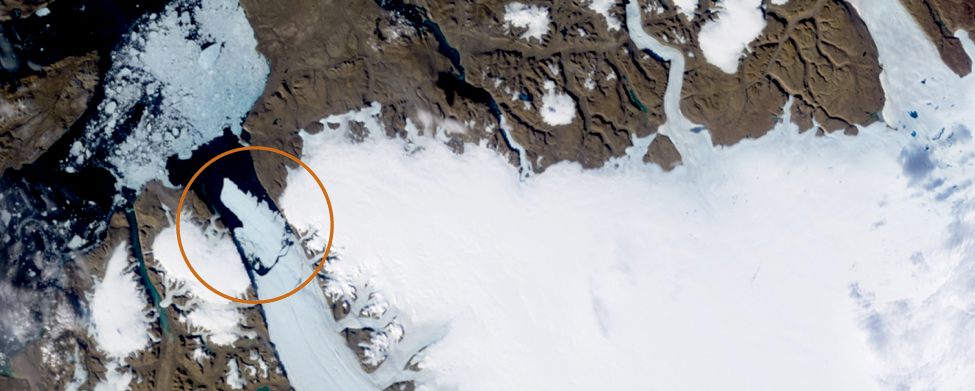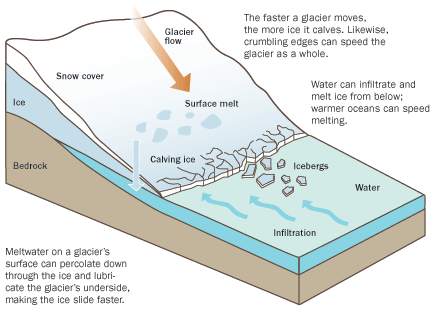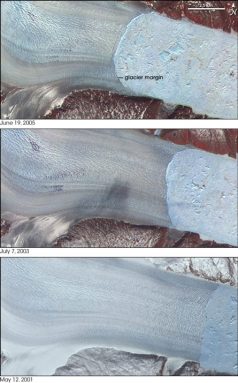Ice on the move
Flowing glaciers help scientists study climate change

The biggest Arctic iceberg in five decades (circled) broke off Green lands Petermann Glacier on August 4, 2010.
NASA
The ice cubes you put in a drink may seem pretty solid to you. But if you had a really, really big blob of ice, it could actually flow, like a very slow river. Gravity would pull it downhill.
These moving chunks of ice are called glaciers. They sit in very cold, very high places like the tops of mountains or near the North and South Poles. You might have seen pictures of glaciers from Glacier National Park in Montana. Or maybe you know someone who took a cruise to Alaska.
Scientists are interested in glaciers because these chunks of ice can be used to study global warming. People are putting more carbon dioxide gas into the Earth’s atmosphere, or air, every year by doing things like burning coal for electricity. Like a blanket in the atmosphere, that carbon dioxide traps heat and warms the planet.
Most of that warming has happened in Earth’s frozen regions, so glaciers there are melting. Researchers are trying to study glaciers before they disappear.
Many scientists are interested in glaciers that flow into the ocean, such as the ones you’d see on an Alaskan cruise. When those glaciers melt, their ice turns into water that flows into the ocean. This added water causes sea levels to rise. Researchers are worried that melting glaciers could one day make sea level rise so much that coastal cities, like Miami and New Orleans, might start to go underwater.
But it turns out that glaciers respond to warmer temperatures in lots of different ways. When some glaciers start to melt, they speed up their movement and flow faster and faster to the sea. Others start out fast, but then slow down again.
Slip sliding away
Ice scientists do a lot of their work in Greenland, an island that sits in the North Atlantic Ocean between the United States and Europe. Greenland is the world’s largest island, and about 80 percent of its surface is covered by ice. If all the ice atop Greenland melted, sea levels would rise by about 20 feet worldwide.
That’s not going to happen anytime soon, but some of Greenland’s glaciers have been pretty active lately. One of the fastest-moving glaciers in the world, called Jakobshavn (pronounced YAH-kubs-hav’ un), is on Greenland’s west coast.

Today, Jakobshavn is breaking off more icebergs than it has in a long time. Scientists don’t know why, but in the late 1990s the glacier started moving faster toward the sea. It started melting more and thinning. Scientists think that pretty soon Jakobshavn will stop flowing into the ocean altogether and instead retreat back onto land. The glacier “is in a death spiral,” says Ian Howat, a glaciologist (someone who studies glaciers) at Ohio State University in Columbus.Every summer, scientists go to Jakobshavn to measure how it is changing. They put instruments on the ice that can measure how fast it is flowing. They take pictures of how the glacier changes from year to year (see sidebar). They place seismic stations on the ice, which measure the shaking within the glacier as an iceberg breaks off its end. Scientists call these movements “glacial earthquakes.”
Researchers also want to see what happens when ice on top of the glacier melts. In the summer’s heat, big meltwater puddles appear all over Greenland’s surface. In some places, cracks open up and the water drains down through the remaining ice like water swirling down a bathtub drain.
In 2008, researchers from NASA’s Jet Propulsion Laboratory in Pasadena, Calif., wanted to see where that water went. So they dropped 90 rubber duckies, like the kind you’d see in a bathtub, into the meltwater drains on Jakobshavn. The scientists hoped the duckies might pop out downstream, in the ocean below the glacier. But no one ever saw them again.

Cold ice, warm water
Another place researchers are studying glaciers is on the east side of Greenland, at a glacier called Helheim. Like its western cousin, Helheim recently began flowing faster. But unlike Jakobshavn, Helheim eventually slowed down.
Helheim meets the ocean in a narrow, water-filled canyon called a fjord (fee-YORD). For the past couple of years, a research team has been visiting that fjord. Fiammetta Straneo, an oceanographer at the Woods Hole Oceanographic Institution in Massachusetts, leads that team.
“We’re trying to understand what controls how much melt is happening” to the glacier, Straneo explains. So she hires local fishing vessels to sail her into the fjord. There she lowers long cables into the water to measure the temperature of the ocean.
As she gets closer to where the glacier meets the water, there are so many icebergs around that it gets dangerous to stay in the boat. So Straneo hires helicopters to fly her over the end of the glacier. There she drops more instruments into the water to measure the temperature again.
Straneo has discovered that waters in the fjord are some of the warmest around Greenland. The warm water seems to be coming from hundreds of miles off the island and flowing into the fjord. When the glacier runs into the water, the ice melts faster than it would if the water were colder. “It’s like putting an ice cube in a warm bathtub,” she says.
As Earth’s temperature continues to rise, that bathtub will only get warmer. So scientists will probably be in Greenland for many summers to come. Only then can they better understand glaciers and what will happen to them during climate change.
Sidebar: Where art meets science
When James Balog was growing up in northern New Jersey, he didn’t just have a rock and mineral collection like many kids. He also knew that the rocks beneath his feet formed when Europe and North America pulled away from each other hundreds of millions of years ago.
Today, Balog (pronounced BAY-log) still straddles the worlds of science and wonder. He’s a photographer whose latest project looks at how the planet’s ice is disappearing. His Extreme Ice Survey puts cameras on glaciers and other frozen places to photograph the landscape. A few months or years later, project members go back to pick up the cameras and assemble the pictures into dramatic time-lapse movies that show the glaciers melting or the ice retreating. Right now, the team has 31 cameras in places including the Himalaya Mountains, Greenland, Iceland, Montana and Alaska.
The movies are a powerful witness to how climate change affects the planet. Features in the ice that had been there for centuries disappear in the blink of an eye. “The whole thing is motivated by me wanting to be able to tell my daughters: I saw it, I was in those places, and I did the best I could to communicate it,” says Balog, who now lives in Boulder, Colo., with 9-year-old Emily and 22-year-old Simone.
Scientifically, he knows what he’s talking about because he has a master’s degree in geomorphology. This means he spent an extra several years after college specifically studying Earth’s geological features and movements. Artistically, he has always been interested in the natural world. His photography books include work on the world’s biggest trees and the relationship between chimpanzees and people.
So what does it take to be both a scientist and an artist? “It’s absolutely critical to be curious, to have imagination and to have energy,” he says. “I also think society in general has a terrible case of nature deficit disorder — forgetting about the connection with what really gives us life.”
So get off the computer, he says, and get outside to play and explore.
POWER WORDS
glacier A big blob of ice that flows downhill like a very slow river
iceberg A chunk of floating ice that broke off the end of a glacier that extends into the ocean
ice sheet A thick layer of ice that covers more than 20,000 square miles of land, like in Greenland and Antarctica
seismic waves Vibrations in the earth caused by earthquakes, explosions, meteorite impacts or other loud bangs
fjord A narrow section of sea between steep cliffs
global warming The warming of the Earth caused by an increase in certain gases, called greenhouse gases, generated by human activity. Carbon dioxide is the main greenhouse gas.







